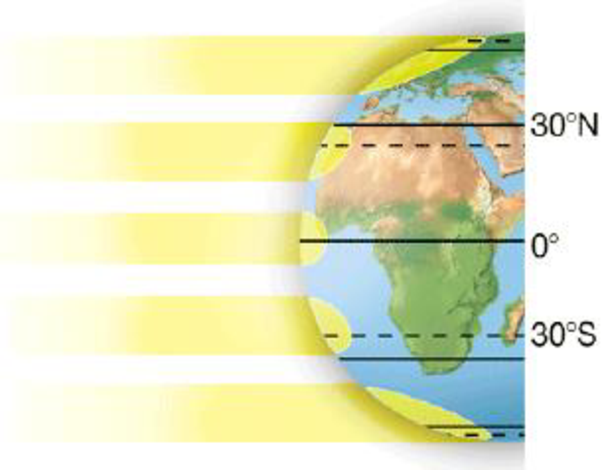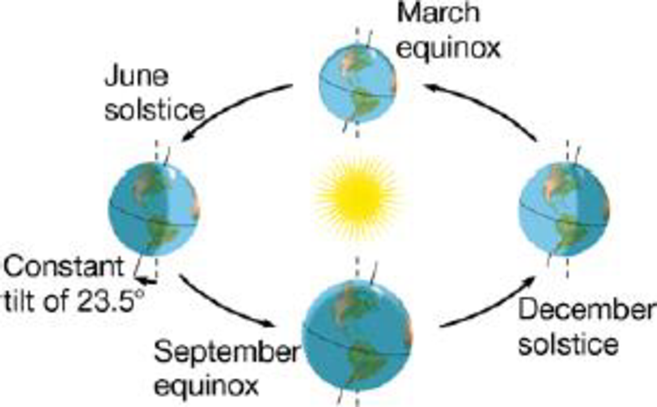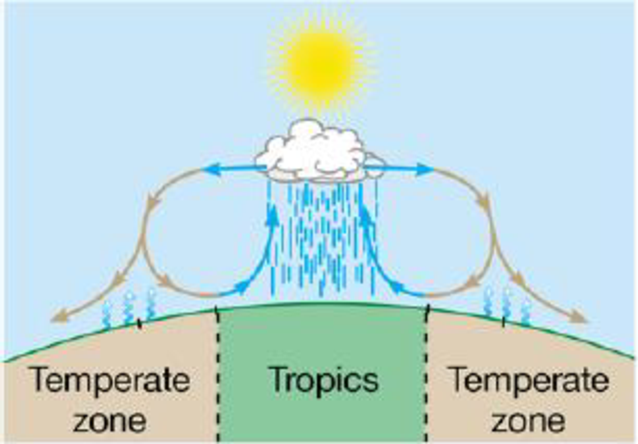
Concept explainers
You have seen that Earth’s terrestrial biomes reflect regional variations in climate. But what determines these climatic variations? Interpret the following diagrams in reference to how each represents effects on global patterns of temperature, rainfall, and winds.
a. Solar radiation and latitude:

b. Earth’s orbit around the sun:

c. Global patterns of air circulation and rainfall:

(a)
To determine: Solar radiation and latitude representing the effects on global pattern of temperature, rainfall and wind and also the climatic variations.
Introduction:
Biomes are the regions with similar climate and terrestrial biome distribution is decided by rainfall and temperature. The terrestrial biomes are tundra, rainforest, desert, taiga, temperate forest, alpine and savanna.
Explanation of Solution
The solar radiation amount received by earth is depends upon the location of the biome. The amount of received sunlight will be high if the biome is located at equator, resulting in hot conditions in biome. At the poles, biomes are cold due to the availability of less sunlight.
(b)
To determine: Earth’s orbit around the sun representing the effects on global pattern of temperature, rainfall and wind and also the climatic variations.
Introduction:
Biomes are the regions with similar climate and terrestrial biome distribution is decided by rainfall and temperature. The terrestrial biomes are tundra, rainforest, desert, taiga, temperate forest, alpine and savanna.
Explanation of Solution
Different seasons are the result of earth rotation, because both hemisphere experience opposite season due to tilt of earth on its own axis.
The tilt of the northern hemisphere of earth towards the sun results in summer as the tilt allows entry of more sunlight and summer in the northern hemisphere means winter in the southern hemisphere because it is away from the sun so receives less sunlight.
(c)
To determine: Global pattern of air circulation and rainfall representing the effects on global pattern of temperature, rainfall and wind and also the climatic variations.
Introduction:
Biomes are the regions with similar climate and terrestrial biome distribution is decided by rainfall and temperature. The terrestrial biomes are tundra, rainforest, desert, taiga, temperate forest, alpine and savanna.
Explanation of Solution
Extreme sunlight at equators results in evaporation of water from the land and oceans, which cools and condenses, converting into rain. For example: tropical rainforests.
At 30 degree latitude of south and north, the circulating air warms as it fals causing evaporation of moisture present in the soil, leading to dryness (arid regions in the temperate zones). For example: deserts.
Want to see more full solutions like this?
Chapter 34 Solutions
Campbell Biology: Concepts & Connections (9th Edition)
- Explain how the hormones of the glands listed below travel around the body to target organs and tissues : Pituitary gland Hypothalamus Thyroid Parathyroid Adrenal Pineal Pancreas(islets of langerhans) Gonads (testes and ovaries) Placentaarrow_forwardWhat are the functions of the hormones produced in the glands listed below: Pituitary gland Hypothalamus Thyroid Parathyroid Adrenal Pineal Pancreas(islets of langerhans) Gonads (testes and ovaries) Placentaarrow_forwardDescribe the hormones produced in the glands listed below: Pituitary gland Hypothalamus Thyroid Parathyroid Adrenal Pineal Pancreas(islets of langerhans) Gonads (testes and ovaries) Placentaarrow_forward
- Please help me calculate drug dosage from the following information: Patient weight: 35 pounds, so 15.9 kilograms (got this by dividing 35 pounds by 2.2 kilograms) Drug dose: 0.05mg/kg Drug concentration: 2mg/mLarrow_forwardA 25-year-old woman presents to the emergency department with a 2-day history of fever, chills, severe headache, and confusion. She recently returned from a trip to sub-Saharan Africa, where she did not take malaria prophylaxis. On examination, she is febrile (39.8°C/103.6°F) and hypotensive. Laboratory studies reveal hemoglobin of 8.0 g/dL, platelet count of 50,000/μL, and evidence of hemoglobinuria. A peripheral blood smear shows ring forms and banana-shaped gametocytes. Which of the following Plasmodium species is most likely responsible for her severe symptoms? A. Plasmodium vivax B. Plasmodium ovale C. Plasmodium malariae D. Plasmodium falciparumarrow_forwardStandard Concentration (caffeine) mg/L Absorbance Reading 10 0.322 20 0.697 40 1.535 60 2.520 80 3.100arrow_forward
- please draw in the answers, thank youarrow_forwarda. On this first grid, assume that the DNA and RNA templates are read left to right. DNA DNA mRNA codon tRNA anticodon polypeptide _strand strand C с A T G A U G C A TRP b. Now do this AGAIN assuming that the DNA and RNA templates are read right to left. DNA DNA strand strand C mRNA codon tRNA anticodon polypeptide 0 A T G A U G с A TRParrow_forwardplease answer all question below with the following answer choice, thank you!arrow_forward
 Biology (MindTap Course List)BiologyISBN:9781337392938Author:Eldra Solomon, Charles Martin, Diana W. Martin, Linda R. BergPublisher:Cengage Learning
Biology (MindTap Course List)BiologyISBN:9781337392938Author:Eldra Solomon, Charles Martin, Diana W. Martin, Linda R. BergPublisher:Cengage Learning Concepts of BiologyBiologyISBN:9781938168116Author:Samantha Fowler, Rebecca Roush, James WisePublisher:OpenStax College
Concepts of BiologyBiologyISBN:9781938168116Author:Samantha Fowler, Rebecca Roush, James WisePublisher:OpenStax College Biology: The Dynamic Science (MindTap Course List)BiologyISBN:9781305389892Author:Peter J. Russell, Paul E. Hertz, Beverly McMillanPublisher:Cengage Learning
Biology: The Dynamic Science (MindTap Course List)BiologyISBN:9781305389892Author:Peter J. Russell, Paul E. Hertz, Beverly McMillanPublisher:Cengage Learning Human Biology (MindTap Course List)BiologyISBN:9781305112100Author:Cecie Starr, Beverly McMillanPublisher:Cengage Learning
Human Biology (MindTap Course List)BiologyISBN:9781305112100Author:Cecie Starr, Beverly McMillanPublisher:Cengage Learning
 Biology 2eBiologyISBN:9781947172517Author:Matthew Douglas, Jung Choi, Mary Ann ClarkPublisher:OpenStax
Biology 2eBiologyISBN:9781947172517Author:Matthew Douglas, Jung Choi, Mary Ann ClarkPublisher:OpenStax





